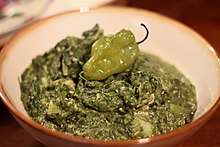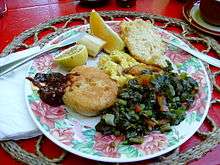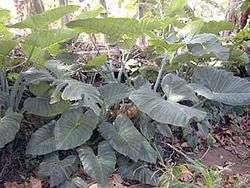Callaloo
Callaloo (sometimes callalloo, calalloo, calaloo or kallaloo) is a popular Caribbean vegetable dish. There are many variants across the Caribbean, depending on the availability of local vegetables. The main ingredient is an indigenous leaf vegetable, traditionally either amaranth (known by many local names including callaloo, but not Spinach or bhaaji due to taste and texture), taro (known by many local names, including dasheeen bush, callaloo bush, callaloo, or bush) or Xanthosoma (known by many names, including coco & tannia).
 | |
| Type | Stew |
|---|---|
| Place of origin | Trinidad and Tobago, Jamaica, Dominica |
| Main ingredients | Leaf vegetable (usually taro, amaranth or xanthosoma) |
Since the leaf vegetable used in some regions may be locally called "callaloo" or "callaloo bush" "dasheen Leaves", some confusion can arise among the vegetables and with the dish itself. This, as many other Caribbean dishes are remnants of West African cuisine.[1]
Cooking variations
Outside of the Caribbean, water spinach is occasionally used. Trinidadians, Grenadians and Dominicans primarily use taro/dasheen bush for callaloo, although Dominicans also use water spinach. Jamaicans, Belizeans, St. Lucians and Guyanese on the other hand use the name callaloo to refer to amaranth, and use it in a plethora of dishes and also a drink ('callaloo juice').[2] The 'callaloo' made in Jamaica is different from the 'callaloo' made in Trinidad and Tobago, Grenada and rest of the Caribbean in terms of main ingredient (the leaf used) and other ingredients included.
While Jamaicans tend to steam callaloo leaf with tomatoes, salt, peppers, onions, scallions, with or without salt-fish, Trinidadians and Saint Lucians use Callaloo leaves/ dasheen bush, okra, coconut milk, pumpkin, onions, bell peppers, local seasonings and spices along with crabs or pigtails. "Callaloo" in Trinidad is used in a variety of dishes including Callaloo soup or "oil down". Callaloo is the National Dish of the twin Island Republic of Trinidad and Tobago and the Commonwealth of Dominica.
Plant sources for callaloo leaves
- Taro, also called dasheen in the West Indies, the leaves of this root crop are used in the Trinidadian version of the dish.
- Tannia or malanga (Xanthosoma) called calalu in Puerto Rico
- Amaranth species include Amaranthus spinosus used in the West Indies; Amaranthus flavus is a yellow variety used in Brazil and known as caruru; Amaranthus viridis in Jamaica ; Amaranthus tricolor in the Caribbean
- Pokeweed species, Phytolacca octandra or "West Indian foxglove" (no relation to garden foxglove, genus Digitalis)
- Nightshade species, Solanum americanum
- Water spinach (Ipomoea aquatica; a form of morning glory) In India(state ofAndhra and Telangana) people uses leafy vegetable (Thothakura)
Callaloo recipes

Callaloo in Trinidad & Tobago and other eastern Caribbean countries is generally made with okra and dasheen or water spinach Ipomoea aquatica. There are many variations of callaloo which may include coconut milk, crab, conch, Caribbean lobster, meats, pumpkin, chili peppers, and other seasonings such as chopped onions and garlic. The ingredients are added and simmered down to a somewhat stew-like consistency. When done, callaloo is dark green in colour and is served as a side dish which may be used as a gravy for other food.
Callaloo is widely known throughout the Caribbean and has a distinctively Caribbean origin, utilising indigenous (Xanthosoma) plants and modified with African influences, such as okra. (See Palaver sauce for the West African dish.). Trinidadians have embraced this dish from their ancestors and over time have added ingredients such as coconut milk to modify its flavour. Callaloo is mostly served as a side dish, for Trinidadians, Bajans, and Grenadians it usually accompanies rice, macaroni pie, and a meat of choice. In Guyana it is made in various ways without okra.
In Jamaica, callaloo is often combined with saltfish and is usually seasoned with tomatoes, onion, escallion, scotch bonnet peppers and margarine/cooking oil and steamed. It is often eaten with roasted breadfruit, boiled green bananas and dumplings and it is a popular breakfast dish.
In Grenada, callaloo is steamed with garlic, onion and coconut milk and often eaten as a side dish. Grenadians also stir or blend the mixture until it has a smooth consistent texture. Callaloo soup comprising callaloo, okra (optional), dumplings, ground provision like yam, potato (sweet and "Irish") chicken and beef is traditionally eaten on Saturdays. It is also one of the most important ingredient in Oil Down, the Island's National Dish comprising steamed breadfruit, callaloo, dumplings, ground provision, carrot and several varieties of meat--salt fish, chicken, pork. All of this is steamed in coconut milk and saffron powder. Salt and pepper is added. Due to the high iron content of callaloo, Grenadians douse it down with a fruit drink high in Vitamin C especially as Iron could only be absorbed in the presence of Vitamin C.
In the Virgin Islands, callaloo is served with a dish of fungee on the side.
In Guadeloupe, "calalou au crabe" (crab callaloo) is a traditional Easter dish.
A similar variation is the recipe called "Laing" which is popular in the Philippines, mainly the Bicol region.
See also
- List of Jamaican dishes
- List of stews
- Trinidad and Tobago cuisine
References
- "Kreyol [ Haitian Creole ] Dictionary". kreyol.com.
- Higman, B. W. “Jamaican Versions of Callaloo.” Callaloo, vol. 30, no. 1, 2007, pp. 351–368. JSTOR, www.jstor.org/stable/30135936.
- Davidson, Alan. Oxford Companion to Food (1999), "Callaloo". p. 125 ISBN 0-19-211579-0
- Callaloo - Volume 30, Number 1, Winter 2007, pp. 351–368 - Jamaican Versions of Callaloo
External links

